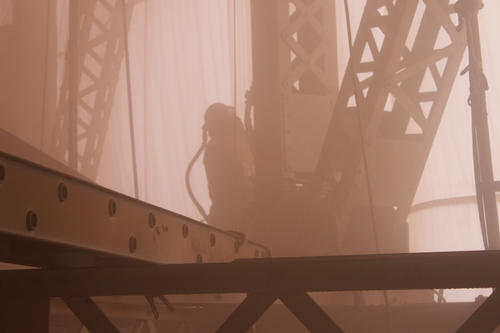TUESDAY, JUNE 27, 2017
The Occupational Safety and Health Administration announced Friday (June 23) that it is proposing to revoke certain provisions of its new beryllium rule in the construction and maritime industries, while maintaining the new exposure limits adopted in January.
The proposal, set to be published today (June 27) in the Federal Register, would eliminate housekeeping and personal-protective-equipment requirements in association with the rule for the construction and maritime industries. OSHA says that abrasive blasting in the construction and maritime industries, and welding specifically in maritime, are the only operations in these industries where the beryllium rule is likely to apply.
The proposed changes, the agency says, are based on the fact that there are a number of regulations that already exist to address particulate exposure in those operations.

 |
| Images: Technology Publishing (unless noted) |
|
OSHA has proposed rolling back some requirements for shipyard and construction businesses under the new beryllium rule, noting that there are a number of regulations that already apply to the operations in these industries that present a risk for beryllium exposure: abrasive blasting in the construction and maritime industries, and welding in the maritime industry. |
The new permissible exposure limit of 0.2 micrograms per cubic meter and short-term exposure limit of 2.0 micrograms per cubic meter would remain the same under the revision proposal.
Changes to OSHA regulations that have been promulgated are subject to a lengthy comment and review process. The rule, the compliance date of which is set at March 12, 2018, will not go into effect until the new round of rulemaking procedures is finished, OSHA says. The agency says it is considering extending the compliance dates an additional year for construction and maritime, to allow more time for compliance.
Request for Comment
OSHA is requesting further comment on “whether existing standards covering abrasive blasting in construction, abrasive blasting in shipyards, and welding in shipyards provide adequate protection for workers engaged in these operations.”
Specifically, the agency is looking for “responses, supported by evidence and reason, to the following questions”:
Rule Changes
The ancillary provisions that are subject to revocation include requirements for:
Medical surveillance provisions currently in the new rule include a requirement for an employer to provide beryllium exposure-related medical testings to employees who meet certain criteria, including exposure above the action level of 0.1 micrograms per cubic meter for 30 days a year or more, or showing symptoms of a beryllium-related disease.
Clothing-related provisions would require personal protective equipment and clothing worn by workers in areas of potential beryllium exposure to be laundered onsite and not worn home. OSHA says in its proposed change that it "does not believe that beryllium particles present in abrasive blasting media or welding fume residue that might be brought home on work clothing, shoes and hair would result in exposures at or near the action level" defined by the new rule.
Rule History
The new beryllium rule was published in January after years in development, authored primarily by OSHA, the United Steelworkers union and Materion Brush, the country’s largest supplier of beryllium. In general industry, beryllium is used as an aerospace material, in nuclear reactors and in some medical applications, as well as for other specialized uses.
The rule reduces the eight-hour permissible exposure limit for airborne beryllium from 2.0 micrograms per cubic meter to 0.2 micrograms per cubic meter, a limit that applies to all industries. It also establishes a short-term exposure limit of 2.0 micrograms per cubic meter over a 15-minute sampling period.
Beryllium is a component of coal, certain rock materials, volcanic dust and soil that is used in several industrial applications. Breathing air containing beryllium can deposit beryllium particles in the lungs, presenting immune-system and respiratory risks. Beryllium is a known human carcinogen and can cause chronic lung disease.
 |
| Gage Skidmore, CC BY-SA 2.0, via Wikimedia Commons |
|
The rule’s effective date was pushed back in March as part of a freeze on new and pending regulations that was called for in a memo issued by President Donald J. Trump's chief of staff, Reince Priebus. |
While the rulemaking proposal that was published previous to the actual rule did not apply to the construction and maritime industries, OSHA in the end decided to publish a set of three new beryllium rules, with similar provisions, applying to construction, maritime and general industry.
According to the supporting material accompanying the new proposed rule change, OSHA included construction and maritime “based on supportive testimony and comments from stakeholders along with exposure data in the record indicating the potential for exposures above the action level for abrasive blasting using coal and copper slags.”
The rule’s effective date was pushed back in March as part of a freeze on new and pending regulations that was called for in a memo issued by President Donald J. Trump's chief of staff, Reince Priebus.
Conflicts Over Evidence
An organization representing some suppliers of blasting abrasives, the Abrasive Blasting Manufacturers Alliance, argued during the original rulemaking process, and again after the publication of the rule, that there have historically been no cases of chronic beryllium disease known to have resulted from exposure via abrasive blasting.
OSHA, in its rulemaking documentation, counters that “anecdotal reports are not compelling evidence, especially where there is no surveillance program, required or otherwise.” The agency goes on to say that “the best available evidence indicates that there is a significant risk of CBD and lung cancer to workers in construction and shipyards based on the exposure levels observed.”
 |
|
While its previous rulemaking proposal had excluded the construction and maritime industries, OSHA in the end opted to issue a new beryllium rule for both industries, in which abrasive blasting is a source of potential beryllium exposure. |
“However,” the agency adds, “OSHA welcomes further data and comment on the risks of sensitization, CBD, and lung cancer among workers involved in abrasive blasting and welding operations in shipyards and construction.”
OSHA’s supporting documents also repeatedly specify two particular types of abrasive media, coal slag and copper slag, as putting blasting workers at risk for beryllium exposure. The new rulemaking cites a number of studies performed for the National Institute for Occupational Safety and Health and for academic journals that look specifically at beryllium in mineral slag abrasives.
OSHA has left the door open to further exploration of the risks associated with specific blasting media; the agency says in the new document that it “requests updates on this assessment of commonly used abrasive blasting media in construction and shipyards.”
In contrast with the OSHA documents, the ABMA has cited a 1998 study performed for NIOSH to support its contention that all abrasives, not just slags, have the potential to violate the new exposure limits.
According to an ABMA fact sheet published in February, the alliance includes Abrasives Inc., Canam Minerals Inc., Ensio Resources Inc., Harsco Minerals, Mobile Abrasives Inc., MineralTech Gulf Coast Abrasives LLC and U.S. Minerals Inc.
Industry Response
The ABMA issued a statement Monday (June 26) regarding the proposed rule change.
“OSHA’s proposed updated beryllium rule would be a significant improvement as it would eliminate construction and maritime industries regulations which would be very costly and complex, with no benefit to employee safety and health,” the organization said. “Beryllium is only found in trace amounts in these industries. Unfortunately, the proposed updated rule would still incorporate lower beryllium exposure limits for these industries that are not supported by scientific or medical evidence.
“One important point that has not been addressed by OSHA is that the trace amounts of beryllium in its natural mineral form found in these industries is different than the beryllium alloys and salts utilized in other industries. The type of beryllium matters and not all types of beryllium have been found to have the same health effects and they should not all be regulated the same way.”
Not all abrasive suppliers take issue with the new rule; Scott Trom, general manager of Strategic Materials' abrasives business, calls that company's crushed-glass abrasive media a "safe alternative" and says his company supports the institution of the new exposure limits and ancillary positions.
"Since the beginning, we have supported and will continue to support the current OSHA beryllium exposure rule, published in January 2017, which includes protections like medical surveillance programs for construction and maritime industry workers when using slag abrasives," Trom said in a statement to PaintSquare News. He noted that the company agrees with OSHA's position that current evidence points to "significant" health risks for workers at blasting operations that expose them to beryllium.
The USW’s Michael Wright, who directs safety and environmental programs for the union, said in a statement Friday (June 23), "No worker should have to die from chronic beryllium disease, and the administration has no business discriminating against any group of workers just because they happen to be in the wrong industry. We will vigorously oppose this cruel proposal."
Wright had previously told PaintSquare News that if OSHA moved to eliminate the beryllium rule for the construction and maritime industries, the union would fight to completely eliminate the use of abrasives that pose a risk for beryllium exposure.
Lawsuit Pending
In addition to a petition to stay its effective date, the beryllium rule is subject to a lawsuit in the Eight Circuit Court of Appeals. The suit, Airborn, et al. v. OSHA, et al., is in its early stages, with briefings due July 10.
According to court documents, it is a consolidation of several suits filed by industry groups including: the National Association of Manufacturers, Associated Builders and Contractors, a number of abrasive manufacturers and at least one marine painting firm. The petitioners have not been required to set forth their specific arguments against the rule yet.
Tagged categories: Abrasives; Beryllium; Government; Health & Safety; Health and safety; OSHA; Surface preparation